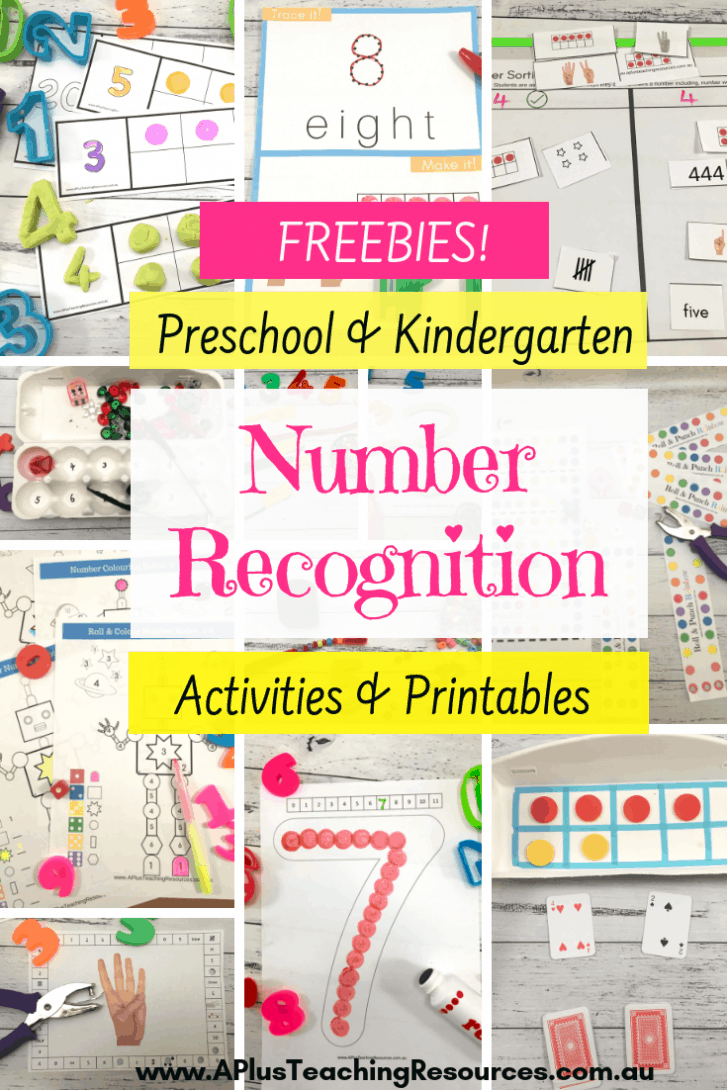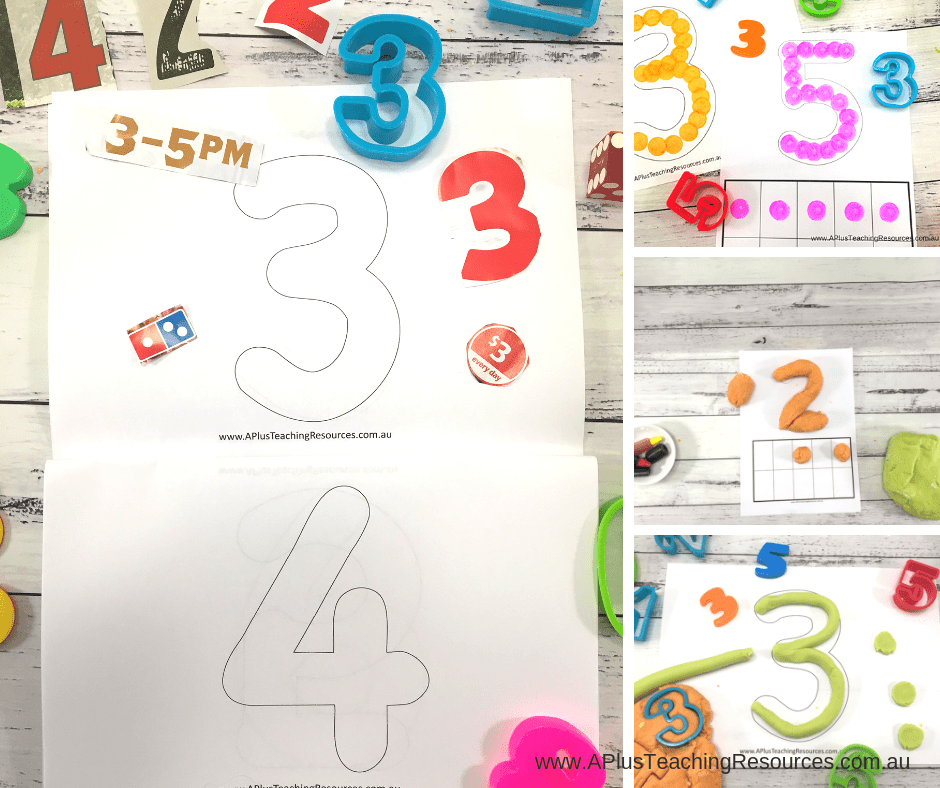Want To Know How To Teach Number Recognition? Then look no further! Here’s our Top Tips for Teachers & Home Schoolers!
Number Recognition is one of the first math concepts that Preschool and Kindergarten kids learn. There’s lots to teach and so many strategies to get your kids to learn. We have quite a collection for you to explore!
Bookmark all these pages and revisit them often. It’s a handy reference for how to teach, Activities, Teacher Worksheets, Freebies, thematic crafts and excellent Products.

*this post contains affiliate links. APTR may receive a small commission for referring your purchases, at no extra cost to you. Thanks for supporting us!
What is Number Recognition?
Number recognition is learning to identify and name numbers and it is one of the first things a kindergarten or pre-schooler will learn how to do.
It is a complicated concept because it involves much more than being able to say a number name. Teaching Number Recognition includes teaching number names, writing and recognising digits, counting and matching numbers to quantity.
Traditional flash-card activities will help with recalling and naming different numbers. But they don’t teach children all the connections between numbers, digits and quantity.

For this to happen children need numerous opportunities to discover and explore the connection between number names, numerals and quantity (counting).
Number recognition can be defined as “the ability to identify and name basic numerals”. Teaching this needs to be broken down into several core mathematical skills:
- matching numbers to quantity
- identifying numbers
- naming numbers
How To Teach Number Recognition
When planning activities it is important to create a range of experiences for the students that don’t just focus on saying or chanting the names of numbers.
Math programs need to include activities, games and learning experiences that teach students depth. They also need to apply their understandings in a variety of situations.
It’s important to make sure the activities you use teach your kids:
- The language of counting – the names of numbers, exposure to numbers and counting in other cultures
- The process of counting– naming the numbers in sequence, forwards and backwards and from any starting point. Building understanding of the number sequence and how all numbers are made from combination of the same digits 0-9. Understanding that numbers are said in a particular order and there are patterns in the way we say them
- Connect number names, numerals and quantities, including zero
- Counting is not chanting it involves a number of steps or “Counting Principles” – understanding that each object must be counted only once, that the arrangement of objects does not affect how many there are, and that the last number counted answers the ‘how many’ question
Numbers Recognition in the Environment
Teaching number recognition includes teaching children about numbers in the environment as well as using numbers in math. So it’s important that they have lots of opportunities to find numbers on everyday items like the:
- TV remotes
- phones
- cars
- traffic signs
- price tags
and that numbers can be found in the classroom, at home, in the playground, at the shops, in fact everywhere!
Number Recognition In Real Life
Children also need to explore how everybody uses numbers everyday. Kids need to learn that numbers are not just for ‘Math’ class. But that they have real life uses, like:
- setting the right number of places at the dinner table
- using 3 different coloured pencils to complete an activity
- getting enough glue sticks for everyone at the table
When students notice that numbers are an essential part of their life, learning numbers becomes more meaningful.
Number Recognition in the Classroom
Teaching programs in the kindergarten classroom need to include opportunities for students to develop the full range and depth on understandings around numbers including:
- match digits, number words and quantity 0-20
- digit formation 0-20
- count a collection to find how many are in it
- know that numbers are in a particular order that we use to count
- compare small quantities
- think mathematically to solve simple word problems
- develop language & terminology of number recognition
Hands-on Activities, Games, Worksheets For Number Recognition
We have a ton of fun, hands-on activities, teacher resources, and free teacher worksheets . Try them next time you’re planning and teaching numeracy, and you’ll get excellent results for your children!
- Construction Playdough /Tracing Math Mats 0-20
- Fine Motor Ideas For teaching number recognition with your Kindergarten, Preschool or Foundation aged kids.
- Do your kids like playing I Spy? They will love learning number names, numerals, and quantity from 0-10 with our number recognition free game
- Our simple number template printables are a really handy free printable to have, they can be used for so many different preschool and kindergarten number recognition activities.
- These FUN number recognition printables will help your kids to learn how to distinguish numerals from letters and learn and practice number words & digits 0-20.
- Your kids will love them!y these simple hole punch fine motor activities for teaching number recognition. Seriously simple but perfect for learning math!
- Number Sort thinkboards for Math are very simple, but a hugely effective addition to your teaching numbers program for o-10. Add this FREE number think board to your number recognition
- These numbers 0-10 hole punch activities are excellent fine motor activities for recognising numbers, digits and quantities, for kindergarten and preschool kids
- STEM Lego Brick Numbers 0-20
- Christmas Number Recognition Printables – Fun engaging activities for the Holiday Season!
Number Recognition Products From A Plus Teaching Resources
Picture Books For Teaching Number Recognition
Click the images below for more teaching number recognition ideas…

Ladybird Subitizing Craft

Number Sort Think Board {Frayer Model Activities 0-10}

Clever Egg Carton Maths Activities {Hands-on Learning}

Roll-A-Dice Snowman Math Game {Subitizing & Number Recognition}

Clothespin Snowman Craft {Free Clip Cards Included!}

FREE Playdough Mats Guaranteed To Make Learning Fun!

Do-A-Dot Fact Fluency Dice Activities {FREEBIES}

Spooktacular Halloween Printable Number Games

Clever Strategies for Teaching Number Recognition You Must Try!

Subitising Egg Carton Activities

Fine Motor Rainbow Math Game

Simple Hole Punch Fine Motor Activities For Teaching Math











[…] number recognition resources are guaranteed to help your kids recognise numbers as numerals, digits, words and […]